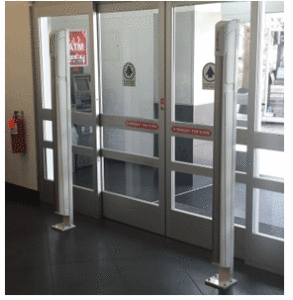 This is the best time for retailers. We make a good chunk of our profits during the last 3 months of our fiscal year. Walk into any major retailer right now and you’ll already see a litany of holiday themed gifts, home décor and all things red and green. We also tend to beef up our staff this time of year as well. Some of us hire part-time works, some may even add a full-time position or two and a great many of us will employ temporary workers. The threat of employee theft also peaks around this time as well.
This is the best time for retailers. We make a good chunk of our profits during the last 3 months of our fiscal year. Walk into any major retailer right now and you’ll already see a litany of holiday themed gifts, home décor and all things red and green. We also tend to beef up our staff this time of year as well. Some of us hire part-time works, some may even add a full-time position or two and a great many of us will employ temporary workers. The threat of employee theft also peaks around this time as well.
I caught a local news story this evening regarding a local store’s employee theft problem. The owner had discovered that one of his part-time employees had been stealing thousands of dollars from him in the form of bogus cash refunds and missing cash sales. So much money was missing, the store was literally on the verge of shutting down. How scary is that thought? One employee had single-handedly brought this man’s business to the verge of collapse. Why? A gambling addiction. So, what can you do to avoid this happening to you? Let’s take a look at this particular fraud scheme, shall we?
Missing cash sales
A dishonest employee can do this in two ways. First, they could legitimately ring up a customer and pocket the cash. They could also fail to ring it through the point of sale and simply accept the exact change from the customer, which would also allow them to pocket the customer’s money, instead of it going into the drawer. So how do you prevent this? First, make sure to reconcile your daily sales with the cash in the drawer. In essence, your POS should be smart enough to tell you how much cash you SHOULD have in the drawer at the end of the night. You count the cash, and it should match up +/-a dollar or two, at most. My dad runs a restaurant with a 10 years old cash register and it has this ability. The only excuse for not doing this is laziness on the manager part. Never assume anything when it comes to your money!
Now, that dishonest employee can take it a step further and never record the sale in the register, just opting to take “exact change” from your customer. Granted, this is very hard to track. Even working for a multi-billion dollar a year corporation with a large LP department with endless resources at my disposal, I still don’t have a magic button that I can press that shows me this fraud. This is where you have to install cameras at your POS. If you think something is suspicious about your sales, or your employee, those cameras can make your case every single time.
Bogus refunds
If you allow refunds, you can open yourself up to “ghost refunds” by your cashiers. This is where the dishonest cashier can simply conduct “refunds” when no one is around, pocketing the cash. On paper, it looks completely legitimate. You know that every day, you generally process x number of refunds, so if the dishonest employee keeps the number of returns they do in line with what’s average, you’ll never suspect a thing. That is until you start realizing that your profits are a lot lower that what they should be. How do you stop it? If your register allows it, require a manger key/password for any return transaction. That way, you, or another manager, has to be involved at the point of sale for any refund. A dishonest employee will not try this route if they know you will scrutinize every refund by physically having to be present.
If your register isn’t that smart, but still allows a refund to be processed, have a policy that states that the cashier must always call a manger for approval. Even if you can’t physically prevent it with a password/key, if you have any refunds on the POS at the end of the night, you’ll be able to see them. If you have a refund where you weren’t called, you can always question the cashier, or look at the transaction on camera, provided you have some installed (which you should) to ensure it was legitimate.
This is just two of the ways that your employees could possibly steal cash from you; there are dozens. Like most LP practices, just a little due-diligence and some common-sense best practices can help save you money and stress if they are implemented. While this isn’t meant to be a comprehensive list, or training guide, it should give you a baseline of where to start, especially if loss prevention isn’t your strongest suit.
 As I sit here on this Halloween night, thinking about how great it was when I was a kid to pillage the neighborhoods for candy and treats, I can’t help but also think about the next 60 days. The real fright comes now for all of us in the retail game. We’ve got so little time to do so very much. We all have new receipts pouring in, plan-o-grams that need setting, bulk stacks that need stacking and bins that need filling; all with the mad hopes of grabbing every possible dollar from now until December 24. A big part of that plan, for most, is hiring temporary help to get us through. Have you ever thought about how these temporary workers can impact your LP goals? With a little training and guidance, they can be one of your greatest holiday assets.
As I sit here on this Halloween night, thinking about how great it was when I was a kid to pillage the neighborhoods for candy and treats, I can’t help but also think about the next 60 days. The real fright comes now for all of us in the retail game. We’ve got so little time to do so very much. We all have new receipts pouring in, plan-o-grams that need setting, bulk stacks that need stacking and bins that need filling; all with the mad hopes of grabbing every possible dollar from now until December 24. A big part of that plan, for most, is hiring temporary help to get us through. Have you ever thought about how these temporary workers can impact your LP goals? With a little training and guidance, they can be one of your greatest holiday assets. Ever given any thought to your receiving area and your back door? How often do you open it and walk away? Do you require a manager be present when it’s open, or do you “trust” your warehouse crew with a key? Have you ever considered that an unattended back door could not only cause shrink, but also compromise the safety of your customer and employees? If you answered yes to any of those questions, you may have a problem.
Ever given any thought to your receiving area and your back door? How often do you open it and walk away? Do you require a manager be present when it’s open, or do you “trust” your warehouse crew with a key? Have you ever considered that an unattended back door could not only cause shrink, but also compromise the safety of your customer and employees? If you answered yes to any of those questions, you may have a problem. It is not surprising that CVS is once again the recipient of a lawsuit.
It is not surprising that CVS is once again the recipient of a lawsuit.
 A good loss prevention plan starts with focusing on the basics. One of the basics is to monitor high risk merchandise. For a variety of reasons some items are stolen more often than others. It makes sense that they should be given extra attention and protection.
A good loss prevention plan starts with focusing on the basics. One of the basics is to monitor high risk merchandise. For a variety of reasons some items are stolen more often than others. It makes sense that they should be given extra attention and protection.
 We are getting ready for an increase in customer traffic. Is your Checkpoint System ready? Are you having false or phantom alarms? Is the system working properly? Have you had your system tuned or a Preventative Maintenance (PM) conducted in the last year or even 5 years?
We are getting ready for an increase in customer traffic. Is your Checkpoint System ready? Are you having false or phantom alarms? Is the system working properly? Have you had your system tuned or a Preventative Maintenance (PM) conducted in the last year or even 5 years?
 Ghosts, goblins, zombies, it’s that time of the year again to dust off the spooky movies and scary tales meant to put a chill up your spine. Hollywood always seems to have a batch of new releases ready about now to evoke nightmares and make us wake up in a cold sweat. We are sure that we see a poltergeist lurking in the corner of the bedroom or in the closet after we watch one of these films. Yes, I admit I am a big coward and have to put my hands over my face and peek out through my fingers to watch Freddy slash his next victim or Jason terrorize a group of kids at a camp in the middle of the woods. But there are real scary stories of my own to share that don’t have anything to do with ghouls. Mine are real-life scary stories of shoplifters I have dealt with during my years in retail Loss Prevention.
Ghosts, goblins, zombies, it’s that time of the year again to dust off the spooky movies and scary tales meant to put a chill up your spine. Hollywood always seems to have a batch of new releases ready about now to evoke nightmares and make us wake up in a cold sweat. We are sure that we see a poltergeist lurking in the corner of the bedroom or in the closet after we watch one of these films. Yes, I admit I am a big coward and have to put my hands over my face and peek out through my fingers to watch Freddy slash his next victim or Jason terrorize a group of kids at a camp in the middle of the woods. But there are real scary stories of my own to share that don’t have anything to do with ghouls. Mine are real-life scary stories of shoplifters I have dealt with during my years in retail Loss Prevention.